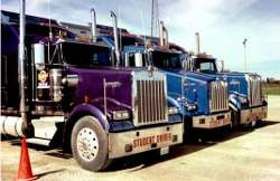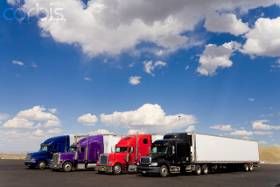Dreams (or Nightmares) About Double Clutching
Topic 602 | Page 1

Yeeeahhh, I'm not lookin' forward to learning the shifting stuff either. We're REALLY gonna find out just how much endurance these transmissions have. 

Its actually pretty basic. You will get the hang of it in no time, practice and repitition.
Brain lag 
Ya know, it's funny but it's true - it is brain lag. But not in a derogatory sense. What's happening is it's taking you just a few moments longer to think things through. You know what to do, but because you're just learning you're having to think a lot more than you will once you get the hang of it. Once the timing and movements become more automatic you'll find your shifting will improve tremendously.
A great parallel to this is in sports. In the NFL for example, you'll hear quarterbacks talk about how "the game slows down" for them after a few years. You'll see that rookies tend to make decisions just a tiny bit too late because they're having to think things through more so than a veteran who has automated a lot of that stuff already. So a rookie always seems like they're a half second late or a half step behind the game. Things are moving just a little bit too quickly for them.
In my opinion, you probably don't need to change anything at all. What I would do is practice shifting on your own. You can sit in a chair or on the side of a bed and go up and down through the gears. Go through the movements as if you're really in a truck doing it. See the RPM gauge in your mind. Say the shift points in your mind with every shift. Use your left leg to double clutch and your right foot for the fuel pedal exactly as you would in the truck.
You do not need to be in the truck to improve your shifting. You can get the same practice both mentally and physically by practicing in a chair. And most importantly, always visualize success when you're practicing. See yourself nailing every gear, every double-clutch, every downshift.
The idea of practicing in a chair will only seem silly until you get back in that truck and suddenly your shifting has improved tremendously. Give it a try. That practice will help you automate some of the things you're having to think about right now and that will put your timing right where it needs to be.
Double Clutch:
To engage and then disengage the clutch twice for every gear change.
When double clutching you will push in the clutch, take the gearshift out of gear, release the clutch, press the clutch in again, shift the gearshift into the next gear, then release the clutch.
This is done on standard transmissions which do not have synchronizers in them, like those found in almost all Class A trucks.

A couple of things hosed up my shifting in the beginning. First was that I pushed the clutch in too far. Now I just barely nudge it. Less distance also means less time involved. Also used to rev way high and 'catch it while it was falling' I.e. I'd get it in gear as the rpms fell. Now I just rev it to the proper shift point. Which saves time also. And it all feels different depending on the weight in the box.
HOS:
Hours Of Service
HOS refers to the logbook hours of service regulations.
Yeah I've started practicing at home. Oddly enough I downshift just fine, it's my upshifting that lags. I only have 4 more days next week and then we test on Friday, so I should have it by then.

The original poster stated that his/her instructor said to start the upshift at 1800 rpm.
Since I am not in school yet, and have not even sat in a truck for over 40 years, what is the range you shift in? More specifically, on the upshift, at what rpm to you shift out of the lower gear and then at what rpm do you shift into the higher gear?
(I realize that engine/transmission combinations may differ, but there is a general answer to my question.)
Lawrence
Still in Plan B

The original poster stated that his/her instructor said to start the upshift at 1800 rpm.
Since I am not in school yet, and have not even sat in a truck for over 40 years, what is the range you shift in? More specifically, on the upshift, at what rpm to you shift out of the lower gear and then at what rpm do you shift into the higher gear?
(I realize that engine/transmission combinations may differ, but there is a general answer to my question.)
Lawrence
Still in Plan B
It really depends on the truck. At school and my first company, upshifting was 1300 to 1500 rpms. This is the "progressive" shifting ranges. At my current company it is around 1500 to1700 rpms.
Dave

Good answer, Dave. All shifting will depend on a few things. 1. Engine size 2. transmission size 3. weight of truck,trailer, and load. And sometimes, some trucks just have gremlins.....
You will learn to find the "sweet spot" to up shift, and down shift....they will be different. Thats why I always hated slip seating. Each truck has its quarks.....You get used to them, then you haveta drive something else....
New Reply:
New! Check out our help videos for a better understanding of our forum features

















Preview:








 TT On Facebook
TT On Facebook
In my 3rd week at CDL school, graduate May 17th. Just wanted to share my funny story of the day. Like everyone else I am grinding gears but it seems my rhythm is like half a second off. My instructor said I should try getting the RPMs to around 1800 before shifting, to compensate for my "brain lag" lol.
I woke up an hour early this morning dreaming about double clutching and could not go back to sleep. Hope it does not happen tomorrow!
CDL:
Commercial Driver's License (CDL)
A CDL is required to drive any of the following vehicles:
Double Clutch:
To engage and then disengage the clutch twice for every gear change.
When double clutching you will push in the clutch, take the gearshift out of gear, release the clutch, press the clutch in again, shift the gearshift into the next gear, then release the clutch.
This is done on standard transmissions which do not have synchronizers in them, like those found in almost all Class A trucks.
Double Clutching:
To engage and then disengage the clutch twice for every gear change.
When double clutching you will push in the clutch, take the gearshift out of gear, release the clutch, press the clutch in again, shift the gearshift into the next gear, then release the clutch.
This is done on standard transmissions which do not have synchronizers in them, like those found in almost all Class A trucks.